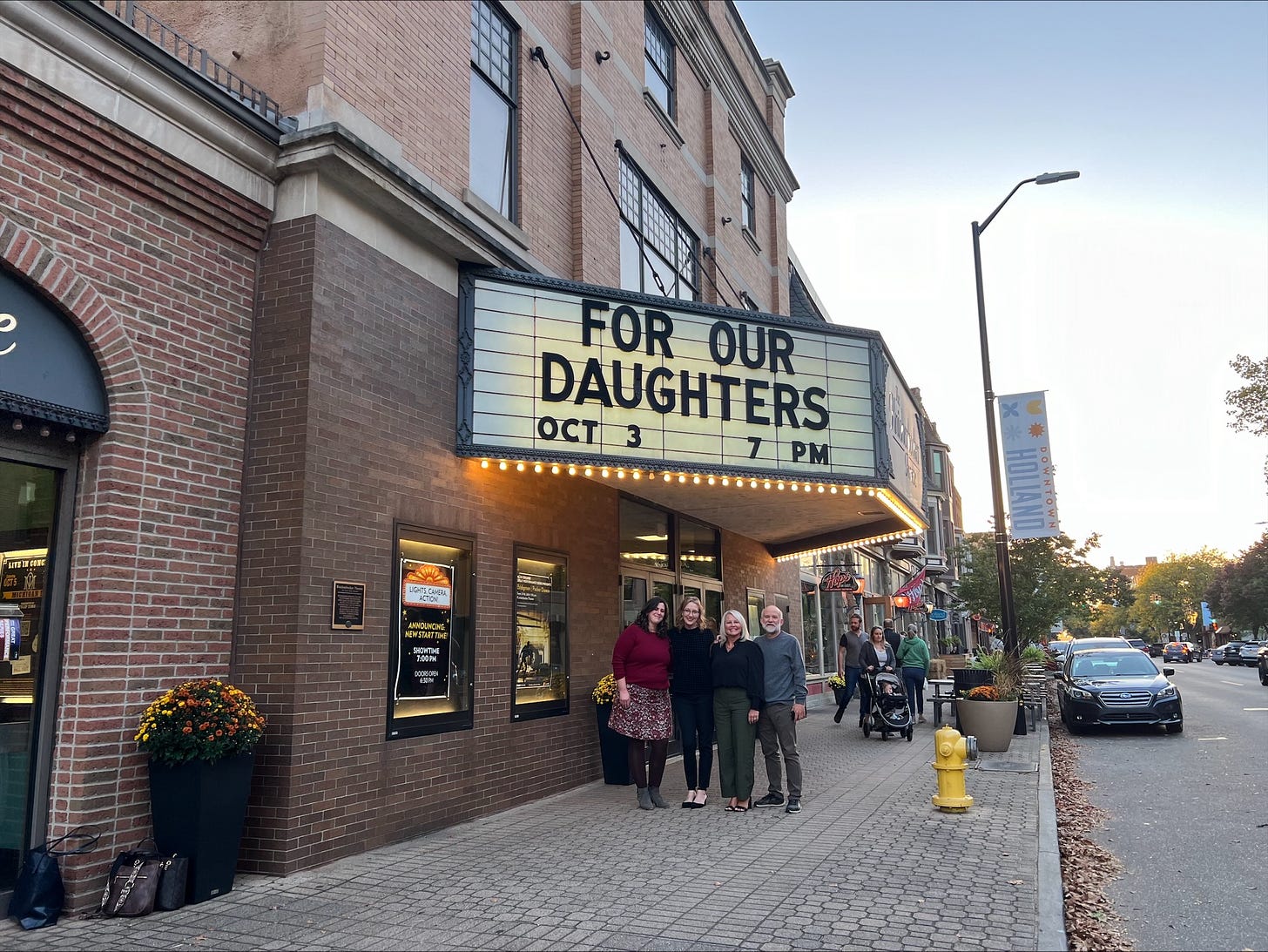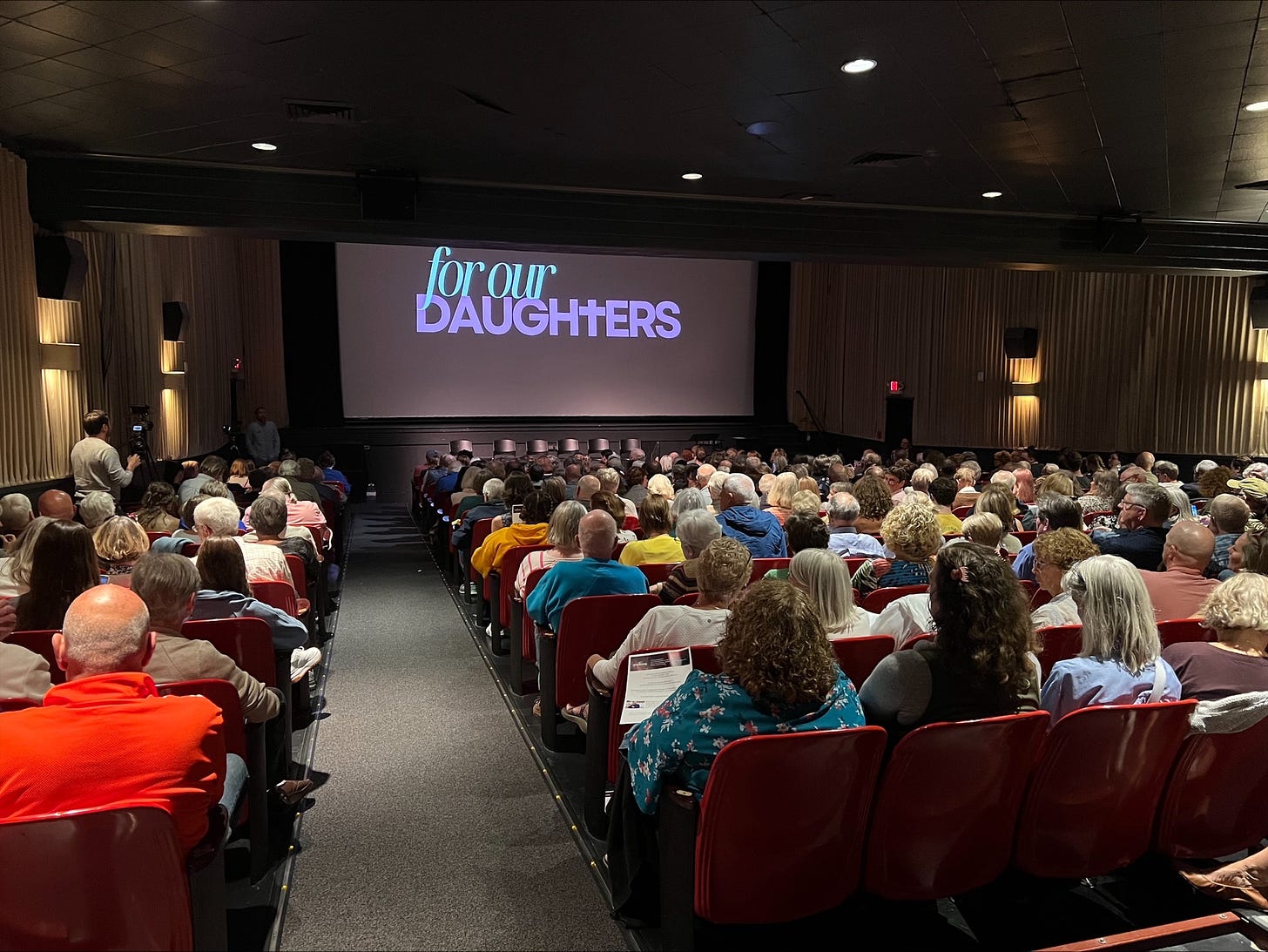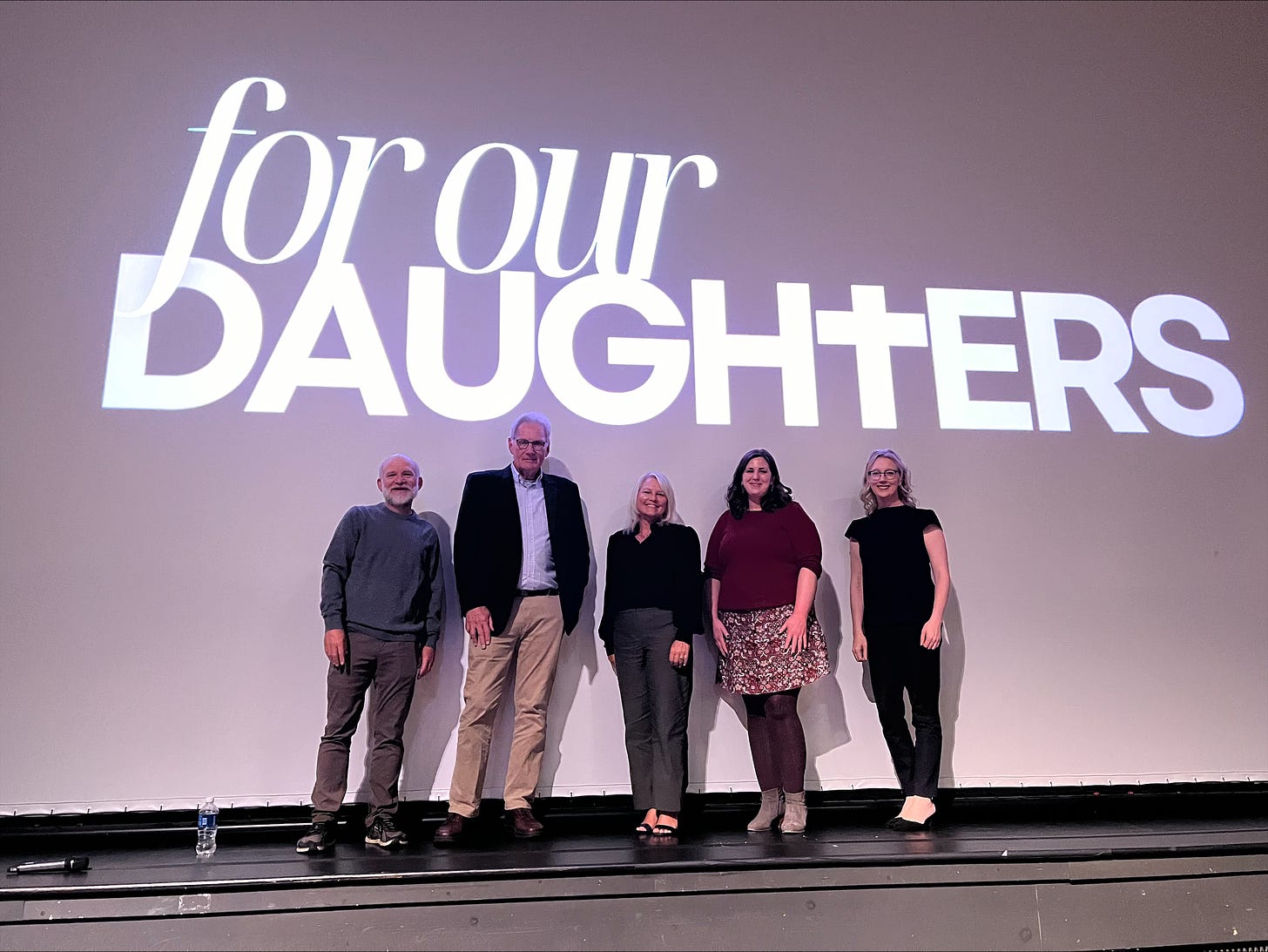Last night we had our first public screening of FOR OUR DAUGHTERS. (Thanks to Marlin Vis and Still Processing for hosting, and to Hope Psychology and Gender Studies departments for helping to sponsor!) It was such a moving experience.
Director Carl Byker and participants Cait West, Tiffany Thigpen, and Len Vander Zee were able to be there and participate in a conversation hosted by Josh Vis. I think we’ll have a video available at some point, but I wanted to reflect on a few highlights to give you a sense of the evening.
First, the theater was filled to capacity. Thank you to all of you W MI (and some Chicago) friends who came to watch and show your support. The theater was buzzing even before we started.
Watching with my daughter sitting next to me, and in the company of Cait, Tiffany, and Len, and with director Carl Byker, who spent countless hours crafting the film, was both beautiful and poignant.
The conversation that followed was also beautiful and poignant, both for what was said and how it was received. It was so clear to me that those who had come were not just moved, but moved to action. It was clear, too, that there were many survivors of abuse in the audience. We could sense the gratitude and resolve.
One of the more memorable moments for me was when Len Vander Zee struggled to come to terms with his place up front. The survivors had done the courageous things, he said, and he was just…just preaching the gospel. What he heard, over and over again, was that far too many in attendance had never heard that kind of preaching. They’d never encountered that kind of gentleness and humility in a preacher. They’d never encountered that gospel.
I loved, too, how panelists could be honest with where they were with respect to their faith. Cait explained that she wasn’t active in her faith, that she was “probably the most agnostic one up here.” (Our moderator quickly corrected her, claiming that title for himself.) I thought back to when I first invited Cait to participate. She wanted to do so, but wanted to warn me that she didn’t consider herself a Christian anymore and would understand if I didn’t want her in the film for that reason. I assured her that I wanted participants to speak on their own terms and that was perfectly fine. We were telling the truth, not fabricating a narrative.
Perhaps the most stunning moment for me was when Tiffany, overcome with emotion, said that this was the first time she’d ever spoken before an audience that was not hostile.
The first time.
Ever.
She has been advocating for abuse reform in churches for years, but has only ever encountered resistance and outright hate. Last night she was greated with overwhelming admiration and gratitude.
At the end of the evening, the audience rose to their feet and applauded. Carl, Len, and I joined in. We had just watched two abusers get standing ovations onscreen. Now, we gave Cait and Tiffany the standing ovation they deserved. One that was long, long overdue.
It was at that moment that I realized that while I had been thinking we were bringing in participants for the benefit of the audience—to educate and inspire, which they did—equally important was what the audience gave them in return.
Working in abuse reform is brutal. The women in this film have worked so hard and so long, and very, very few people have come alongside them. It really is stunning. But last night, five hundred people had a chance to do so. And it was a beautiful thing.
In that moment, I realized that this film is a gift. It is a gift to survivors, a gift to the church, but also a gift to each one of us. It gives each of us an opportunity to do the right thing, pick the right side. To amplify their voices, to have the conversations, to change the systems.
I cannot tell you how many people have already come up to me or written me to tell me what the film has done for them as a survivor, or as someone who knows a survivor—many of these are survivors who have never spoken out.
The only way we break this pattern is to confront it head-on. There are somewhere between 20- and 30,000 people who will read this Substack post. We can make an enormous difference.
So here’s what I’d like to ask you to do.
Share the film on your social media. Volunteer to host a screening at your church, and lead a conversation. (We have a discussion guide prepared for you here on our website!) If you do this, take a picture and post on social media and tag us @ForOurDaughtersFilm. You can find a social media toolkit here. And links to our trailer here:
You can also host a virtual watch party. (When you do this, too, post pics and tag us, and we’ll re-share!)
There are two ways to do this. You can use Zoom or another standard platform, or you can do it the fancy way and use Kinema, a platform designed for exactly this sort of thing.
Please watch. Please share. Please talk about this. Please show survivors that they’re not alone.
For directions on how to host and promote your watch party (and free graphics), click here. Scroll down and find the simple steps to host on Kinema.
If you want to use Zoom or another familiar platform, Cait just hosted a viewing party on Zoom last weekend and she’s written up some tips on her Substack that I’ll share here.
I’d never had a watch party before, so I wasn’t sure how it would all go. Would I be able to figure out any technical problems? How would I make it an engaging experience for the audience? Would anyone even show up?
In the end, the screening went off without a hitch, many people attended, and we had a meaningful conversation after watching the film. And in the process, I learned a few things about how to make a virtual watch party successful that I wanted to share in case others would like to host their own screening of For Our Daughters.
Schedule a time that is easy for most people to attend. I scheduled my watch party for a Saturday evening after running a poll on my social media to see when people would be most free. Give yourself enough time in advance to send out your invites and prepare how you’d like the watch party to go.
Pick a platform for your watch party. I used Zoom, with a Workplace Pro account so that I wasn’t limited by time (the free version of Zoom cuts off after 40 minutes). You can use Zoom to schedule a meeting and pick settings that fit your context. Depending on your group size and what kind of conversation you want to have, as host you can choose to have everyone muted as they log on so that there is no noise disruption.
Consider what you’d like to achieve with the watch party. Do you want conversation through a chat feature during the film? Would you like to build in time before and after the video for live conversation or a Q&A? Do you want to provide your viewers with a call to action at the end or share a link for more resources?
Do a test run ahead of time. You’re going to want to practice how the watch party will go to sort out any technical issues. Because I wanted to share the video through Zoom, I practiced with my husband who signed in to the link from a different computer in a different room. I learned that just sharing my screen meant the audio quality went down when I played the video. I had to ensure that I was not only sharing my screen but sharing my audio, which is a setting you can easily choose before you click share.
Set up an RSVP form. I used Google Forms to gather email addresses and included a basic set of questions, such as “Can you attend?” and “How did you hear about this event?” I also added a comment box in case anyone wanted to share thoughts or questions ahead of the event. Your confirmation message could indicate that the video link will be sent out via email. I’d recommend setting a time that the RSVP form closes so that you don’t miss anyone who signs up after you email out the video link. One reason to use an RSVP system instead of posting the video link publicly online is to ensure that trolls are less likely to join the watch party. In my case, because I was showing a video about abuse, I wanted to be especially careful about this.
Email viewers with the video link. On the day of the watch party, send out an email with all the necessary details: the time (and time zone) the party will start, the general agenda of what will be included, and the link to the video. You can also include any other details to let people know about the event. For instance, with some videos, you might want to include a content warning or age recommendation. Make sure to use the BCC feature on the email so that you’re not sharing people’s email addresses with each other for privacy reasons.
Start the watch party on time! Make sure you are ready a few minutes ahead of time to start the Zoom and begin the watch party. Once you log in, you might want to wait a few minutes to give everyone time to join. Then, you can introduce yourself, let everyone know how the event will go, and start the video, being sure to share both video and audio. With For Our Daughters, the video is on YouTube, so all I had to do is have the video set up in a web browser, share the screen with audio, and click play. I also made sure to mute myself and everyone else. Turning off your own video is also helpful to avoid distracting viewers from the film.
Encourage conversation. Use the chat box during the film to make comments and encourage others to leave their own comments and questions. This is one of the main reason people enjoy watch parties—talking with others about their reactions.
Transition to Q&A. After the film is over, stop sharing your screen and turn on your video and microphone. This could be an optional time for Q&A, in which viewers ask you questions, or it could be a time for you to ask conversation-starter questions to the viewers. In my case, I had a friend who is familiar with the issues in the documentary help me moderate questions and keep track of time. Having more than one host can decrease the pressure on one person to make the event meaningful.
Close out the event. Have an idea in mind of when you’d like the conversation to end, thank everyone for coming, and close out the Zoom. You could also send out an additional email to everyone to thank them for attending and to provide any links to other resources.
We’ve learned that this isn’t something that changes from the top. Ask Tiffany, Jules, Christa, and Rachael. Power protects power. Only a grassroots movement will be able to disrupt these patterns. Here’s your chance to help make that happen.







Thank you for both your thoughts and comments on the experience last night and the “hows” of taking action! I’m in.
Thank you Professor Du Mez!
At the risk of not sounding humble enough in regards to your brilliance, and as if a particular thought isn’t already at the forefront of your mind, I would like to share a thought I’ve been having since last night’s viewing of “For Our Daughters”.
Other Authors like Katherine Stewart (“Power Worshippers”), Tim Alberta (“The Kingdom, The Power and The Glory”) et. al. keep me thinking about how action in silos and action in networking are two different methods for achieving change. I love your words “Let’s start a movement.” It speaks in support of networking.
Thank you again!
Sincerely,
Karen (not Karin) Prins